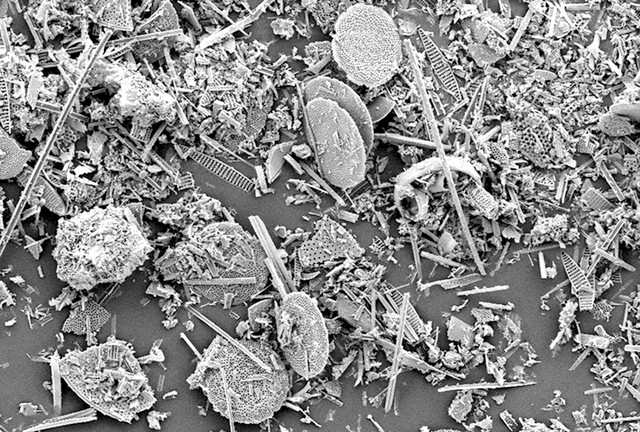
by Sarah Derouin Tuesday, May 1, 2018

A scanning electron microscope image of marine diatom mud. Credit: Gauvain Wiemer/MARUM/University of Bremen.
Far beneath the ocean’s surface, puzzling deposits from huge submarine landslides can be found amid expanses of nearly flat ocean floor. Without steep terrain, what causes these megaslides? In a new study, scientists who delved into deep-sea drilling records report a potential trigger for one such slide off the coast of northwest Africa: diatom ooze.
Submarine landslides are found around the planet. With little to impede their flow and buoyed by seawater, they can reach almost unfathomable scales and travel great distances. For instance, a giant landslide off the coast of Norway that occurred about 8,100 years ago carried more than 3,300 cubic kilometers of sediment. By comparison, the eruption of Mount St. Helens displaced 3 cubic kilometers of material.
Scientists have known for some time that the largest submarine slides actually occur in gently sloping areas along continental slopes, where inclines are less than 3 degrees. “When looking at maps of the seafloor, you see flat, smooth surfaces that look like they were displaced as an entire package,” says Morelia Urlaub, a researcher at GEOMAR in Germany and lead author of the new study in Geology.
To delve into what might trigger such huge slides to occur on gentle underwater slopes, Urlaub and her colleagues studied the large Cap Blanc slide off the coast of Mauritania, where the seabed is smooth and the slope is just 2.8 degrees. The slide has headwalls as tall as 100 meters, where it detached from the adjacent ocean floor.
The team’s supposition was that a weak layer of buried sediment lost strength, causing the whole package of marine sediments to slide downward. Although this hypothesis of submarine landslide triggering is widely considered plausible, testing it has proved difficult. “The problem is that, because the layer is so weak, it most likely vanished with the landslide,” Urlaub says, so the strategy was to study stable sediments from an area next to or upslope of the landslide.
Collecting fresh samples — from depths up to 300 meters below the ocean floor — would have required a costly drilling expedition. Luckily, Urlaub found that, in the 1980s, the Ocean Drilling Program had drilled a deep sediment core and taken an accompanying seismic survey at a site just north of Cap Blanc. This data allowed the team to analyze sediment stacks nearly identical to what failed in the Cap Blanc slide, along with what they saw in the seismic reflections, to find potentially weak layers.
In the sediment core, the team found a possible culprit for the Cap Blanc slide: a layer of diatom ooze about 10 meters thick. Diatoms are microscopic phytoplankton that excrete shells of silica. Urlaub says that, in this area, there must have been a prolonged period of time when phytoplankton bloomed and subsequently died, raining down shells on the seafloor. Eventually, this layer of diatoms was buried by other marine sediments.
“Diatom [shells] are hollow and quite stiff, and sediments made of diatom shells have high porosity,” Urlaub says, adding that when the shells are eventually crushed under the weight of overlying sediment, a layer of water-saturated diatom ooze can form. When a waterlogged diatom layer is quickly compacted, the water must drain somewhere, she says, but impermeable clay layers adjacent to a diatom layer can trap the water, creating the ooze. This, in turn, may decrease the stability of an entire sediment package and trigger a landslide.
“This concept of weak layers has been hypothesized, but very rarely realized for submarine landslides,” says David Mosher, senior research scientist at Natural Resources Canada. Mosher says that such diatom oozes don’t trigger all submarine slides, but Urlaub and her team “make a compelling case that, in this instance, the diatoms are the cause.”
Researchers previously suggested that slides like the one off Mauritania were triggered by earthquakes, but an earthquake “would have to be really, really strong” to produce a slide thousands of cubic kilometers in size, he says. Weak sediment layers that extend over vast areas of seafloor seem to be a much more likely scenario, in which “only one area has to fail and then [that] triggers the rest.”
Understanding how these massive submarine landslides occur has implications for both science and society. “If you know something about the stratigraphy in a certain environment, then you can say something about its risk,” Mosher says. Predicting which areas may be susceptible to large slides, and the potential tsunamis they might cause, can help communities and governments prepare for such events.
Although the depth of the weak layer in the sediments at Cap Blanc has now been narrowed down, “we cannot really pinpoint exactly where the failure took place: Was it in the diatom ooze, was it in the clay, or was it at the interface of the two?” Urlaub says. “We are not there yet — we need to do some more work.”
© 2008-2021. All rights reserved. Any copying, redistribution or retransmission of any of the contents of this service without the expressed written permission of the American Geosciences Institute is expressly prohibited. Click here for all copyright requests.